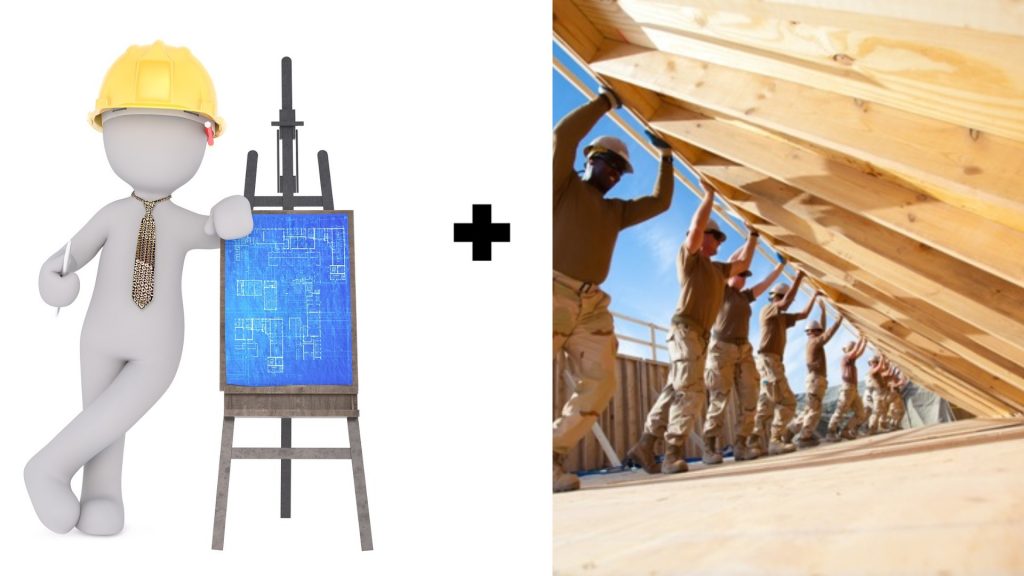Is Design-Build Expensive?
As a leading Houston design-build company, a question we often hear is, “Isn’t design-build expensive?” There isn’t a simple answer to this question because what’s “expensive” is inherently subjective–$50,000 might qualify as expensive to one homeowner, while to another, $500,000 might be no big deal.
An easier question to answer is, “Is design-build more expensive than building or remodeling a home using the design-bid-build method, or buying an existing home?” And the answer is…not necessarily.
Read on to find out how using a design-build company can actually save you money and give you a home you can live in for the rest of your life.
What Is Design-Build?
The traditional construction method is known as “design-bid-build,” wherein homeowners hire an architect to draw up blueprints for a new home or remodel, which they then take to a builder. The builder may then subcontract the work, so at the very least, the homeowner is dealing with two separate contracts and two (or more) firms – the architect and the builder.
The design-build method simplifies this process by giving the homeowner one unified team to work with. Having the architect and builder employed by the same company, working hand-in-hand all the way from concept and design through construction and follow-up, is the crucial difference between the two methods that opens the door to higher efficiency and lower costs. Learn more about how design-build works and the exact step-by-step process.

Design-Build vs. Design-Bid-Build: A Look at the Numbers
Bearing in mind that home remodeling costs depend on a wide variety of factors including geographic location, size of the home, materials used, and more, let’s consider some of the average costs for the design-build model compared to design-bid-build.
Although the two methods are usually considered in the context of remodeling or new home construction, many homeowners choose to hire a designer when renovating or adding a kitchen or bathroom. According to Angie’s List, kitchen remodels between $10,000 and $20,000 will cost between $1,500 and $3,000 in designer fees. Because of this, many homeowners have begun opting for skipping a designer and trusting their remodel design to experienced remodelers.
New home construction is where the cost differences are especially noticeable. According to HomeAdvisor, the national average for hiring an architect is $5,124. However, this includes remodeling projects; some architects’ fees are calculated as a percentage of new home construction costs, meaning they could easily soar if the architect isn’t on the same page as the builder regarding what construction will actually cost.
Architects may instead charge by the total square feet of the project or an hourly rate, which can leave you with an expensive bill if the property is large or the architect is the principal of the company who commands upwards of $150 per hour. With a design-build firm, the cost of the architect will be itemized yet built into the overall cost of the project, so while it won’t be free, it should certainly be lower than an architect on an hourly or square-footage-based rate.
A Detailed Breakdown: Design-Build vs Design-Bid-Build
How Design-Build Translates to Savings
“A penny saved is a penny earned,” as the saying goes. While a remodel using a design-build process might not be the least expensive, it may result in the lowest cost to your bank account in the long run. The following are some of the potential money-saving avenues design-build offers:
- Risk minimization: As design-build firms take on the two leading roles in a project – design and construction – they also inherit more risk. However, in terms of cost risks, they are better positioned to deal with those risks for two key reasons. Firstly, by working together through the design phase, change orders are kept to a minimum. Change orders are a fairly common feature of any new home construction or remodel that are acceptable as long as they’re approved by the homeowner. However, crossed wires among the architect/designer, builder, and homeowner can result in massive rework costs. In fact, construction software company PlanGrid recently found that miscommunication is the source of 48% of all construction rework in the U.S. to the tune of $31.8 billion in 2018. A responsible design-build firm will not only hold multiple planning and pricing meetings with you during the design phase, they’ll check in with you consistently throughout the construction process to ensure there’s no need for costly rework.
Secondly, having experienced contractors involved early in the design stage means costs are more accurately defined from the start. In design-bid-build, designers can sometimes be wildly off in their price estimations and when contractors come back with bids out of your budget, the whole process needs to start again and homeowners need to reach into their pockets for another set of design plans.
- Lasting enjoyment: Design-build may very well be more expensive in the short-term compared to buying a prefab home or housing development, but what about the long-term? This is where the ability to customize your home pays off, from the bathroom fixtures to the kitchen layout to the arrangement of the second story: instead of having to go back in after 15 or 20 years to do costly additions or renovations, you already have a home built or remodeled exactly to your preferences.
- Efficiency: A home designed and remodeled with energy efficiency in mind can lower your monthly energy bills. And the fewer barriers to communication between the builder and architect, the more likely you are to achieve a sustainable design that looks and works great. As an added bonus, the tools and resources involved in green building can help protect your family’s health and lower medical costs. For example, our climate control solutions at Legal Eagle Contractors can mitigate mold, mildew, and allergens in the air.
- Tax breaks: Although a design-bid-build home would also qualify, a design-build home gets the benefit of savings through tax credits and tax deductions. These include federal and state tax breaks for green building, deduction of state sales taxes on building materials, and writing off construction loan interest.
- Resale value: This is something many homeowners might not consider when building or remodeling a home, and the same is likely true for a contracted architect. But a general contractor that is intimately familiar with what construction trends are popular because they’re constantly building new projects is a fantastic resource to have when it comes to designing a home. If you express to your design-builder that selling the home is a possibility at some point in the near future, they can help you strike a balance between your personal taste and broader appeal.
Other Intangibles to Consider
It’s not always a universal truth in the construction industry, but it’s worth remembering that sometimes, you get what you pay for. In other words, the price tag for a reputable design-build firm may come in higher than XYZ Builders, but you need to take into account intangibles like reliability, flexibility, craftsmanship, professionalism, and warranty.
When you’re working closely with a design-builder, you should be able to get a reasonably good feel for how they do business, and as long as the relationship between the two of you is solid, you should end up with a successful project at a price you’re satisfied with.






